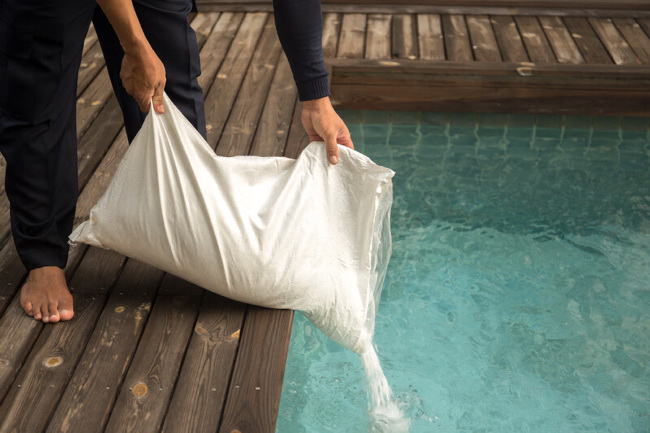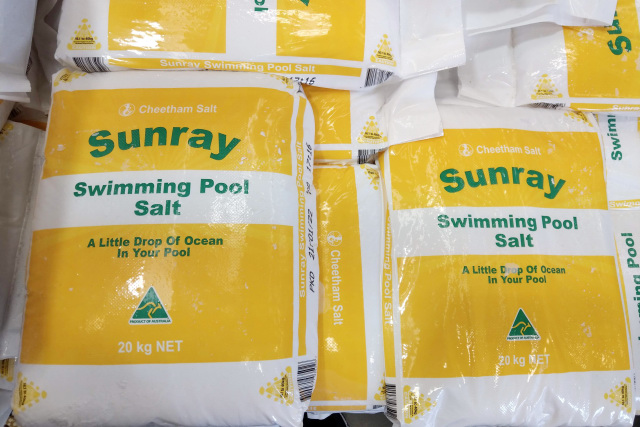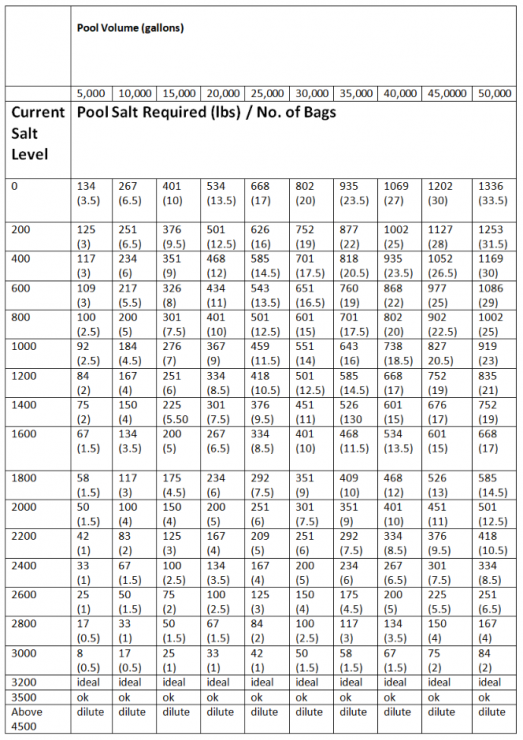Saltwater pools have witnessed a gradual increase in popularity. Adoption of salt as a disinfectant of swimming pools owes to its advantage of making the water feel softer and their easier maintenance.
A salt pool should maintain stable pH and alkalinity and correct stabilizer levels to maximize sanitizing effectiveness just like a regular chlorine pool.
As a saltwater pool system owner, you most probably would be wondering whether your salt pool level is at its correct concentration to enable swimming. This may be sorted by occasionally testing the pool and adjusting the level but just how much salt should you use to adjust the levels?
Most saltwater pools need a salt level of between 2,500 and 3,500 ppm of salt. A regular 40 lb (20 kg) bag of pool salt will raise the pool salt level by 450 ppm for every 10,000 gallons of pool water. For a 10,000-gallon pool with no salt in it, you will need about 7 bags of salt to get 3,000 ppm of salt.
There’s a little more to it though. Let’s find out how to calculate the amount of salt you need for your pool.

Article Contents
How Does Salt Work In Pools?
Salt (Sodium Chloride) is used in saltwater pool systems to sanitize the water. The salt is dissolved in the pool water and drawn into the pool salt cell to generate chlorine in a process called electrolysis. This produces sodium hypochlorite (aka Chlorine) which is the pool’s primary disinfecting agent.
The Salt Cell is what makes the salt to be utilized otherwise just pouring the salt without the salt cell will result in salty pool water. And salt alone i.e. without chlorine will not sanitize your pool.
When Do I Know My Pool Needs Salt?
Often the most frequent question you ask yourself is when to use the salt into the water. When do I need to add salt to the pool or when should I reduce it?
There are two ways to know if your pool needs salt:
- The “check salt” light turns on, on your saltwater chlorine generator control panel.
- Test the pool water.
Although the warning light on your SWG (Saltwater Chlorine Generator) is helpful, it’s not always accurate. The only accurate way to test your salt levels (salinity) is by testing the pool water with a test kit.
How Do You Test Your Pool Salt Levels?
Testing ensures there’s sufficient salt for the system to work to optimal performance. To get your pool’s true salt readings, ensure your pool water level is at the pool’s rated capacity. Top it up if it’s too low or reduce it if it’s too high.
You can choose any of the below ways to conduct your taste.
- Check on the Salt Chlorine Generator (they have a Tri-Sensor that tell you when you need to add salt).
- Purchase a home saltwater test kit.
- Purchase test strips (comes with a comparative chart).
- Take a sample of the water to a nearby pool store for the test.
The resultant test would show a normal, higher, or lower pool salt level.
1. Use the Salt Chlorine Generator Indicator
As mentioned earlier, the salt chlorine generator isn’t always accurate and they don’t always tell you the exact salt level, only if it’s high or low.
2. Use Test Strips
Test strips are OK for testing but again, they’re not the most accurate around. Inaccurate water testing causes many pool water issues. I would only use these if you didn’t have access to other testing methods.
3. Take a Water Sample to the Pool Store
Taking the water to the pool store is normally pretty good. However, then you’ve got the inconvenience and another errand to run.
4. Use a High Quality Drop Pool Test Kit
Out of all of the testing methods, this is my recommendation for the best way. If you get a quality drop testing kit, they are accurate and easy to use. And you won’t need to drive to the pool store every time you want to test.
Let me stress the word quality. Your testing results will only be as good as the kit. A good kit will save you money in the long run. Many pool problems are caused by inaccurate water tests. Without the right numbers, you’ll be adding the wrong chemicals and/or wrong amounts, which will hurt your wallet.
Here’s a quality test kit, I recommend.
- For saltwater pools
- Extremely accurate
- Tests 7 things including salt, pH, chlorine, cyanuric acid
Correct Salt Level for Pool
The amount of salt you need for your pool depends on your salt cell generator. The salt cell generator used in a pool depends on the pool capacity
The ideal level of dissolved salt in the pool is between 2,500 and 3,500 PPM (parts per million).
This range is safe for swimming and much less than sea salt, a level of approximately 34,000 ppm.
Some SWG will need higher salt levels whilst others need lower ones.
What Causes Higher Pool Salt Levels?
Readings from your test may be showing levels above 6,000ppm. This may be considered an overly salted pool. The high salt level may be caused by
- A miscalculation of how much salt to add
- Inaccurate test results or poor quality test kits
- Water evaporation – which increases salt concentration (salt doesn’t evaporate or degrade)
As a result, the high salt concentration in your pool may result
- Unswimmable pool (overly salty-tasting water)
- Corrosion damage to pool equipment.
- Salt cell not working or not working properly
How Can I Lower the Pool Salt Level?
After testing for high salt levels on your pool you can take the step to reduce the salt level to enable you to attain a swimmable level by diluting the pool. This can only be achieved by partially draining your salted pool and topping it up with fresh water using your garden hose pipe.
Here’s how to calculate how much water to drain.
- Divide your salt cell generator recommended ppm (let’s say 3,500) by current salt level reading (say 6,000 ppm).
- Convert into a percentage (multiplying by 100%)
- Subtract the result from 100%
- The resultant percentage you get is the percentage of water in your pool you need to drain and refill.
For Example:
Let’s say you have a 4,755 gal (18,000 L) capacity pool running on a salt cell generator with recommended ppm level of 3,200 and your current salt level reading is 6,000ppm (higher than normal).
Salt Cell Optimum – 3,500 ppm
Current Reading – 6,000 ppm
3,500 / 6,000 = 0.583
0.583 x 100 = 58.3%
(100-58.3)%
41.7% – pool capacity to drain
(41.7% / 100) x 18,000
= 7,506 L
To know how much to drain, your calculations will be as below:
3,200 (salt cell recommendation) / 6,000 (current salt level readings) = 0.583
0.583 x 100% = 58.3%
100 – 58.3% = 41.7% (percentage of water to drain from pool)
41.7% X 4755 gal /18,000 L (pool capacity)
To Drain = 1,983 gal (7506 L)
The work above shows that your salt level is almost twice the recommended amount and thus to reduce the ppm to the recommended level you’ll have to drain out 1,983 gal (7506 L) of water and top up with an equal amount of fresh water.
Once done topping up, circulate the water with the pump/filter for 24 hours then proceed with testing the salt level again and you should achieve the recommended salt ppm.
You may refer to our article How To Lower High Salt Level in Pool (Too Much Salt) to learn how to correct salt levels.
Low Pool Salt Levels
Over time and with use, the pool may have low salt levels. Salt levels reduce when your pool water gets diluted. That means the more people swim and water splashes out of the pool there will be a need to top up the lost water.
And also adding freshwater will dilute your initial salt levels resulting in low salt readings.
Diluted pool salt levels may also be caused by rainwater. Rain may increase the pool water level and, even just an inch, can cause a big drop in the salinity level of your pool (increase pool water volume).
Too low salt results in the saltwater cell generator not being able to properly sanitize the pool. This may require you to boost your salt levels to achieve the recommended ppm.
How to Calculate Required Pool Salt
For efficient functioning of your salt cell, the correct amount of salt should be added to water to achieve the ideal pool salt level.
1. Determine Your Pool’s Volume
Before you can know how much salt to add, you have to determine how much water is being held in your pool (pool capacity)
You can use the formulae below to obtain your pool capacity
G = A x AD x 7.48
Where:
G=volume in Gallons
A=Pool Area (Length by width)
AD=Average depth (deep end height + shallow end height divided by two)
7.48=Gallons contained per cubic foot. (28.3 L)
The below chart summarizes pool volume calculations
| Oval | 3.142 (π )x ½ width x ½ length x depth x 7.48 gal (28.3 L) | |
| Circular | 3.142(π )x radius2 x height(depth)x 7.48 gal (28.3 L) | |
| Rectangular | Length(l)x width(w)x depth(h) x 7.48 gal (28.3 L) |
2. Test the Current Salt Levels
Now you want to take a sample of your pool water and use one of the methods mentioned above to test the salt level. Before you start, make sure the pool water level is correct.
3. Calculate PPM Amount to Raise Salt Level By
After obtaining your pool capacity and current salt level, you’ll then proceed to calculate how much you need to raise salt levels by.
That’s easy with this formula:
Current Salt Level – Optimal Salt Value
Use the table below or look at the user manual to obtain the correct salt value for your saltwater chlorine generator.
E.g. If your current salt level is 3,000 ppm and you have a Zodiac salt system that recommends a salt level of 3,600 ppm, you’ll need to raise the salt levels by 600 ppm (3,600 – 3,000 = 600 ppm).
The below list summarizes common salt cell brands with their recommended salinity levels
| Salinity Display(ppm) | Optimal value(ppm) | |
| Zodiac | 3,500-4,500 | 3,600 |
| Solaxx | 3,500-4,500 | 3,500-4,500 |
| Intex | 3,000-4,000 | 3,200 |
| Jandy | 3,000-3,500 | 3,200 |
| Hayward | 2,800-4,300 | 3,200 |
| Circupool | 2,800-4,500 | 3,500 |
| Pentair | 3,200-3,400 | 3,200 |
4. Calculate the Amount of Salt to Add
Now you know how much you need to raise your salt levels. Using the previous example of 600 ppm we now need to calculate how many bags of salt to add.
This is the amount of salt you’ll need to raise your pool ppm to recommended levels.
How Much Does a Bag of Salt Increase Salt PPM?
Before we can calculate how many bags of salt to add, we need to know how much a bag of salt will increase salt ppm.
A bag of 40lb (20kg) of regular pool salt raises pool salt level by 450 ppm for every 10,000 gallons of pool water.
How Many Bags of Salt Do you Need?

We’ll work out the answer with math first. Or if you want a shortcut, jump down to the table below.
Continuing our example, we need to increase our salt level by 600 ppm and we know 1 bag of salt will increase 10,000 gal of pool water by 450 ppm.
Use this formula:
Amount to Increase Salt By / 450
Example:
For this example, let’s assume we have a 10,000 gal pool. Now take 600 ppm (our current salt level) and divide by 450 ppm. We need 1.3 bags of salt.
The table below will help you calculate how many 40 lbs bags of salt you require to bring your pool to a proper range (3,200 ppm). These calculations are for 5,000 gallons of water.
| Current Salt Level | Salt Required (lbs)/No. of bags |
| 0 | 134 (3.5) |
| 200 | 125 (3) |
| 400 | 117 (3) |
| 600 | 109 (3) |
| 800 | 100 (2.5) |
| 1000 | 92 (2.5) |
| 1200 | 84 (2) |
| 1400 | 75 (2) |
| 1600 | 67 (1.5) |
| 1800 | 58 (1.5) |
| 2000 | 50 (1.5) |
| 2200 | 42 (1) |
| 2400 | 33 (1) |
| 2600 | 25 (1) |
| 2800 | 17 (0.5) |
| 3000 | 8 (0.5) |
| 3200 | ideal |
| 3500 | ok |
| Above 4500 | dilute |
And here’s a more detailed table showing you how much salt (how many bags) you need for your pool.

Printable Download –> How Much Salt?
Want to print the table above. Hit the button below to download a printable version.
Should I Just Pour My Salt Over the Water?
For efficient distribution of your salt, don’t just dump your bag of salt in the pool. The salt should be evenly distributed to prevent it from concentrating and settling at the pool bottom. Salt is can then be easily utilized by the salt cell.
To correctly add the salt to your pool:
- Turn off Your Salt Chlorine Generator (cycling water may result in the salt not getting to some pool parts as it’s absorbed into the system quickly).
- Add the Salt (evenly pour the salt all around the pool perimeter in a slow steady stream).
- Test the Pool.
Is a Salt Pool Free from Chlorine?
Salt pools are still sanitized using chlorine. The salt cell generator produces pool chlorine from a small amount of pool salt that is dissolved into the pool water to provide for the pool’s sanitizing needs
Saltwater pools can also require a stabilizer (cyanuric acid) to help stop the sun’s UV rays from breaking down free chlorine in the pool.
Can I Just Use Any Salt for My Pool?
Pure salt with no additives is the best for your pool. It helps you minimize damage risk caused by additives to your pool chlorinator, skimmer, and other components.
The following are the best recommended for your pool
- Mined salt (has a purity of 95-99% in sodium chloride).
- Solar salt: seawater that’s diverted to a holding area where the sun evaporates the water, leaving the salt.
- Mechanically Evaporated Salt: water dried using an artificial heat source. Not commonly recommended due to high content of contaminants.
It’s always best to use salt labeled as “Pool Salt” that way you know it will do the job.
Here’s our article that covers the Ideal Pool Salt Options for a Saltwater Pool.
Can I Add Salt to the Kid’s Pool?
Whilst it is OK to add salt to a kiddie pool, it will not have the same disinfection power as chlorine will. If your goal is to keep the water longer in your kiddie pool and prevent bugs and algae, you’ll need to add chlorine.
Adding salt without a saltwater generator will not create chlorine. To add chlorine, add it in the form of bleach or use pool chlorines like dichlor.
Conclusion
Having gone through our article above we can now get to comfortably boost our salt pool levels. As we look to wind we can have a few takeaways.
- Keep the Pool Open Until the salt is completely dissolved in the water
- Under heavy rains ensure you cover your pool to avoid dilution.
To keep your pool safe at all times, ensure to be constantly checking on your pool salt levels. This helps avoid the buildup of chemicals that may damage your pool as a result of overtime salt usage or the salt levels running too low. The too low salt level will cost you more in boosting.



How much should a 40lb bag of high quality salt cost?
In 2023 it’s $6 to $40 per bag. You don’t need to pay $40. As long as it’s pure salt for a pool you should be right.
Need more help to maintain my pool 65000 and how many bags of salt do I have to add